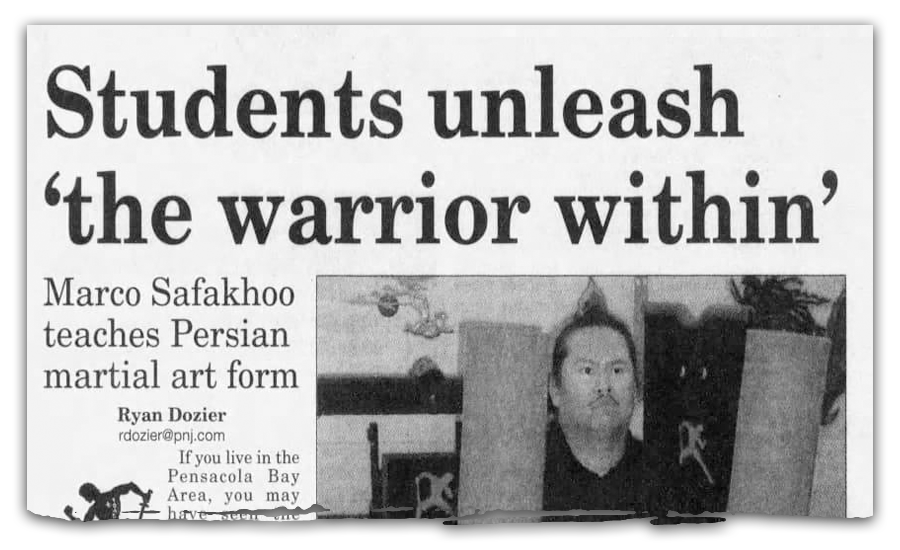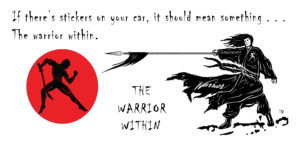
Marco Safakhoo teaches Persian maRtial art form
As seen in the Pensacola News Journal – Tuesday, August 14, 2007
If you live in the Pensacola Bay Area, you may have seen the symbol stuck to the side of a lamp post or on the bumper of a car.
The symbol represents a Warrior within that can be awakened through rigorous physical and mental training.
Grandmaster Marco Safakboo, 50, has been offering the skills and training necessary to become one with the warrior within since 1983 in his school of TOAS (Transcendental Organized Applicable Strategies) Nabard, the Persian art of combat, at 6209 Schwab Drive. Safakboo created this system of fighting based on the original martial art form of Nabard, the fighting system used in ancient Persia (modern day Iran).
“(What I love about teaching is) understanding how people think, how people learn,” Safakhoo said. “I love being able lo teach someone something that I created and see the result of my teaching within that person.” Safakhoo’s teaching is adaptive to the needs and abilities of any student, no matter their age or physical prowess.
“I have a lot of respect for other martial arts schools, and their art and their effort,” Safakhoo said. “It is an honor to take a martial art to discover yourself.
“I teach the art of combat. It is different by concept. I don’t have any kind of promotional games. I don’t have any kind of false sense of security. J teach the students the reality of life. If you are looking for something that you can use to defend yourself! think you will benefit from my school. [f you’re looking for something that challenges you and promotes physical health, you will benefit from my school. I can teach and adapt my art to suit people based on their weight, age and physical capabilities and limitations.”
The students of this school have a great respect and appreciation for their master.
John Estares, a 15-year student, finds Safakhoo’s system to be a great change from other martial art I systems.
“His style is original,” Estares said. “He revolutionized martial arts. His technique is multifaceted and is adaptable and interchangeable in its concept. The intensity and the integrity of the school is great. There is no hiding the truth about your abilities and no false sense of security.”
The school also is family-oriented. It is not uncommon for an entire family to train and learn with each other.
Keith White, his wife Michelle, and their son Gregory, 12, have been going to Master Safakhoo’s school as a family for almost two years. Keith feels that training as a family not only strengthens the family unit but also helps ease his mind when worrying about his family’s safety.
“I am now more comfortable that my wife is more aware and able to defend herself, and I feel the same way about my son,” Keith White said.
Susan Cruz, 48, a three-year student of Safakhoo, said the training is comprehensive and well tailored to an individual’s priorities, body type and abilities. “l think it is challenging,” Cruz said. “Tho people are great. I can see progress. IL Leaches you not only health and wellness but also lessons in courage, discipline, dedication, patience, and self-esteem. All these are good life lessons that. you learn in martial arts.”
training RECEIVES Hollywood exposure!
My Invention used in the Movie "This Means War". LOG TRAINING come experience it for yourself.
Posted by Nabard Combat-Fitness North on Tuesday, December 20, 2016
Log Training Device As seen in the 2012 action-comedy This Means War, starring Reese Witherspoon, Tom Hardy, and Chris Pine

Health Talk: 10 Questions With Marco Safakhoo
by Sean Boone
Marco Safakhoo is the founder of Nabard Fitness Systems in Pensacola. In 1983 he brought his art of Nabard to the United States, and by using his expertise in martial arts combat, created a Log Training regimen to challenge the body to its full potential.
IN: Tell me a little bit about your Log Training workout and what it takes to get the most out of exercising.
Safakhoo: To teach my combat art Nabard, I have to get people in shape and turn them into athletes. However, the fitness industry lacked the necessary equipment and routines, so I created what I needed.
I chose to use natural elements such as rocks and timber-logs. To increase the complexity of movements I fitted timber-logs with the custom handles.
I then offered the training to my students, who range in age from 12 to 75 years old.
IN: What are some easy ways to get back into exercising for people who don’t have a lot of time?
Safakhoo: There are 24 hours in a day. It’s a matter of how you choose to spend them. There are no short-cuts or easy fixes when it comes to maintaining good health. If you choose to exercise, the right way is to exercise for the sake of exercising; the wrong way is to exercise as a diet. Attitude is very important. If you have negative feelings associated with exercise, you must change those before you can enjoy the rewards of health.
IN: Do you have any recommended routines or workout machines?
Safakhoo: Fitness machines have their place, but not in a raw natural routine. Machines of any sort are designed to make our lives and work easier; the last thing I want my workouts to be is easier. Raw natural fitness is best for a raw natural body. A routine must work within the body’s limitations while adjusting to one’s increasing capabilities.
IN: Why is fitness your passion?
Safakhoo: Fitness is my passion because I love life. Fitness and health should be everyone’s first love. To be healthy and fit is to love one’s self and celebrate life as we were intended to. Life is constantly in motion. Fitness is the way to move with purpose and feel alive.
IN: What makes a good fitness trainer?
Safakhoo: I’ve never understood why someone seeking fitness would expect results from hiring an out-of-shape personal trainer; talk about the blind leading the blind. A fitness trainer is a fitness leader and must be capable and competent to lead.
IN: How do you balance cardio and strength training?
Safakhoo: A good exercise offers cardio and strength training as well as a proper mental challenge.
IN: Which is more important?
Safakhoo: Neither is more important than the other. They are equally important and should not be viewed as separate forms of exercise. Just because we know the scientific difference of each does not mean that they are mutually exclusive.
IN: How many times a week should a person work out?
Safakhoo: Ultimately, our bodies are happiest if we give them daily physical challenge. However, any amount of exercise is better than no exercise. For beginners I suggest at least 30 minutes a day, three times a week. The intensity and quality of the workout is more important than the frequency of use.
IN: What are some good foods to enhance working out and fat burning?
Safakhoo: The only healthy foods are the ones produced by the earth, such as nuts, vegetables, fruits and fish. Many of my favorite raw foods such as garlic, lemon and ginger contain special fat-burning enzymes and minerals, and there are even some foods which increase energy and decrease appetite naturally.
IN: Are sports drinks worth the calories?
Safakhoo: Not only are they not worth the calories, but they aren’t worth all the chemicals they contain either. Water is always the best and most natural thing to quench a body’s thirst.
sean@inweekly.net
“Visualize yourself as a warrior and a warrior you will become.” – Master Safakhoo


Contact Us
6323 Schwab Dr.
Pensacola, Fl 32504
850.346.6088
https://youtube.com/user/THINKTOAS
https://www.facebook.com/NabardFitness
